On 28 November 1893, Māori and European women voted in national elections for the first time in New Zealand, having won a law change on 19 September of that year. Today we introduce two new books for children on the topic of women’s suffrage.
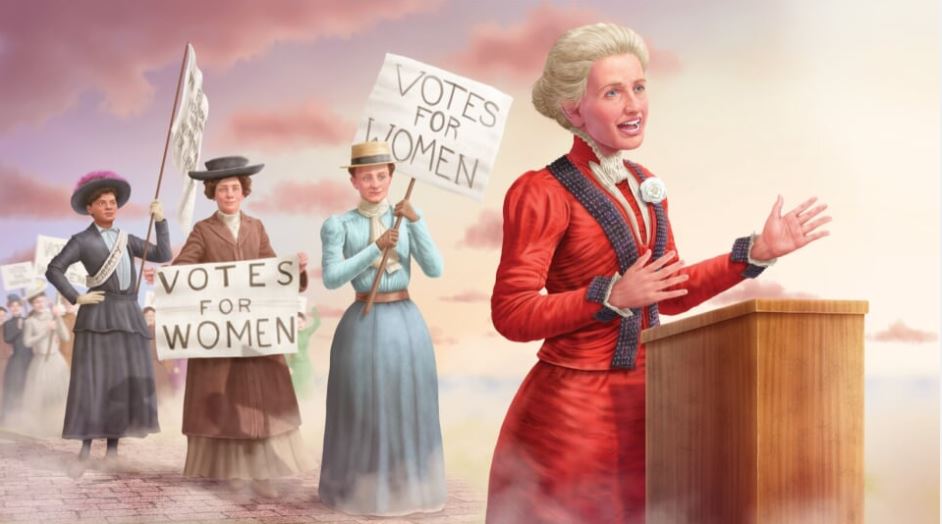
Kate Sheppard: Leading the way for women, by Maria Gill, illustrated by Marco Ivancic (Scholastic)
‘On 28 November 1893, 85 percent of New Zealand’s female population over 21 years – that’s 90,290 – walked to the polling booths and voted for the first time. They were the first women in the world to vote in their country’s elections.’
Experienced non-fiction author Maria Gill has written what appears to be the first picture book biography of Kate Sheppard, the woman who led the campaign in New Zealand to make us the first country in the world to allow women – including Māori women – to vote.
Why has this book not been published before? Why can I not find any sign of a previous children’s biography of Kate Sheppard, one of the most important figures in New Zealand’s history? While I am pleased that this has finally been resolved, I think New Zealand publishers should be looking hard at themselves, not attempting this before 125 years passed since Kate made the history recounted in this book.
This biography does a nice job of giving us a background to Kate’s life, and goes some way towards explaining Kate’s character and passions. She is portrayed as an atypical girl for her time, who preferred to play with the boys, rather than sitting in the parlour being ladylike. Marco Ivancic’s illustration of her booting a football with her brothers is one of the best moments in the illustrations.
I also really enjoyed the design details throughout the book. The front end-papers show the voyage that Kate and the rest of the Malcolm family took when sailing to their new life in New Zealand, where they settled in Christchurch. They did this without her father, who died when she was 14. Soon after moving to Christchurch from Liverpool, she met her future husband on a walk, and while at a music group.
Marco Ivancic’s illustration of her booting a football with her brothers is one of the best moments in the illustrations.
Another design detail is a watermark visible at the bottom of each page spread of legal papers headed ‘The House of Representatives’, which turns out in a later page spread to be one of the many petitions Kate asked her fellow countrywomen to sign.
The story is told primarily in the left-hand column, with a generous spread for illustration beside each snippet. One of Kate’s first rebellions in New Zealand was removing her whale-bone corset, to ride a bicycle. I liked the snippet from the news at the time here, with some snipe noting, ‘I wonder how it is that women who can ride a bicycle day after day couldn’t treadle a sewing machine for an hour, though to the uninitiated the action seems very much the same.’ Jog on, Johnny.
Gill has interwoven dialogue through the story with care, both from Kate’s mouth, and from the mouths of others who interact with her. As Kate goes to a suffragist speech by somebody described as an American woman (this may have been Mary Leavitt, I suspect), she is inspired to help to set up the New Zealand branch of the Temperance Union.
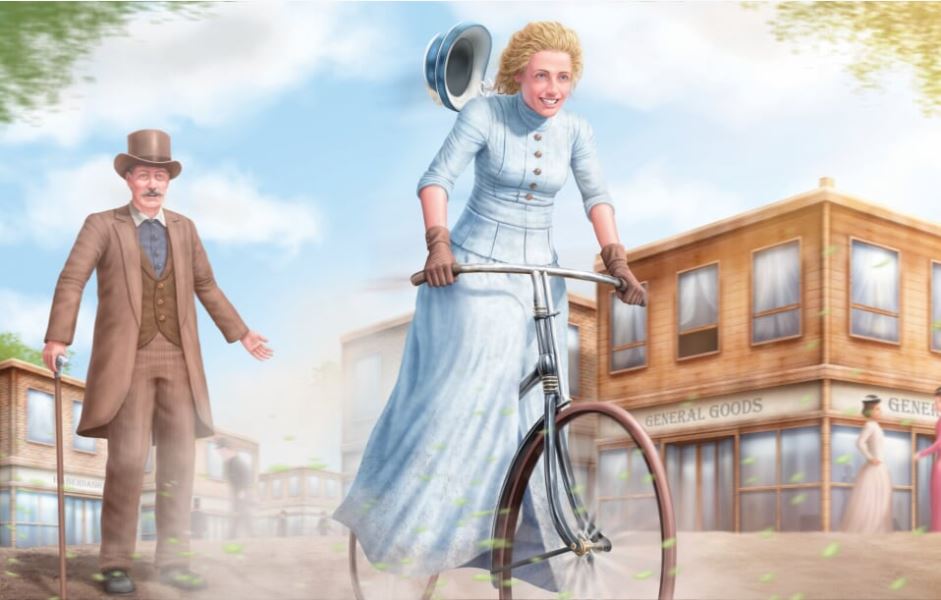
It will be interesting to kids of today that the process of getting women the vote was by no means easy. It required male allies, as well as support from tens of thousands of women, at a time when getting a survey and arranging rallies around the country – even one as small as New Zealand – was quite an undertaking.
Nonetheless, she got 9,000 signatories in 1891, which led to a bill that failed at the second hearing; then 20,274 signatures from rallies and marches across NZ in 1892. Then nearly 32,000 for the third attempt, in 1893. All the while Kate wrote pamphlets, urging women to stand up for their rights, and urging MPs to vote for women to receive the vote. ‘Kate counted all the signatures as she pasted the forms onto 233 metres of wallpaper. “Walter, guess how many women signed?” she said, excitedly.’
The fact that suffrage was extended to Māori women is included as a footnote, and I had to corroborate this from other sources to check it was true as the way it was noted sounded like an aside rather than a fact. The book doesn’t note that it wasn’t universal – Chinese women were still excluded.
The fact recounted at the start of this review is startling. If only 85% of our female population turned out to vote every year. What a powerful thing that would be. In the meantime, just enough of us got there to enable a young, feminist Prime Minister to do a deal to get into power.
The facts included at the back of the book are excellent, with a clear timeline, and more facts about female inequality around the world, countered with successes. Maria Gill does her facts well. The endpapers are even better, indicating when exactly, countries all around the world allowed women to vote. Some, very recently indeed. It’s important for kids to know these realities. Great for all ages, in the hands of a parent or teachers.
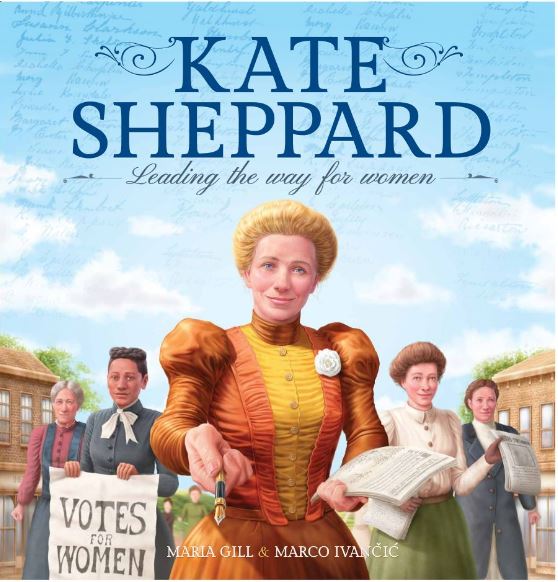
Kate Sheppard: Leading the way for women
By Maria Gill
Illustrated by Marco Ivancic
Scholastic
RRP $28.00
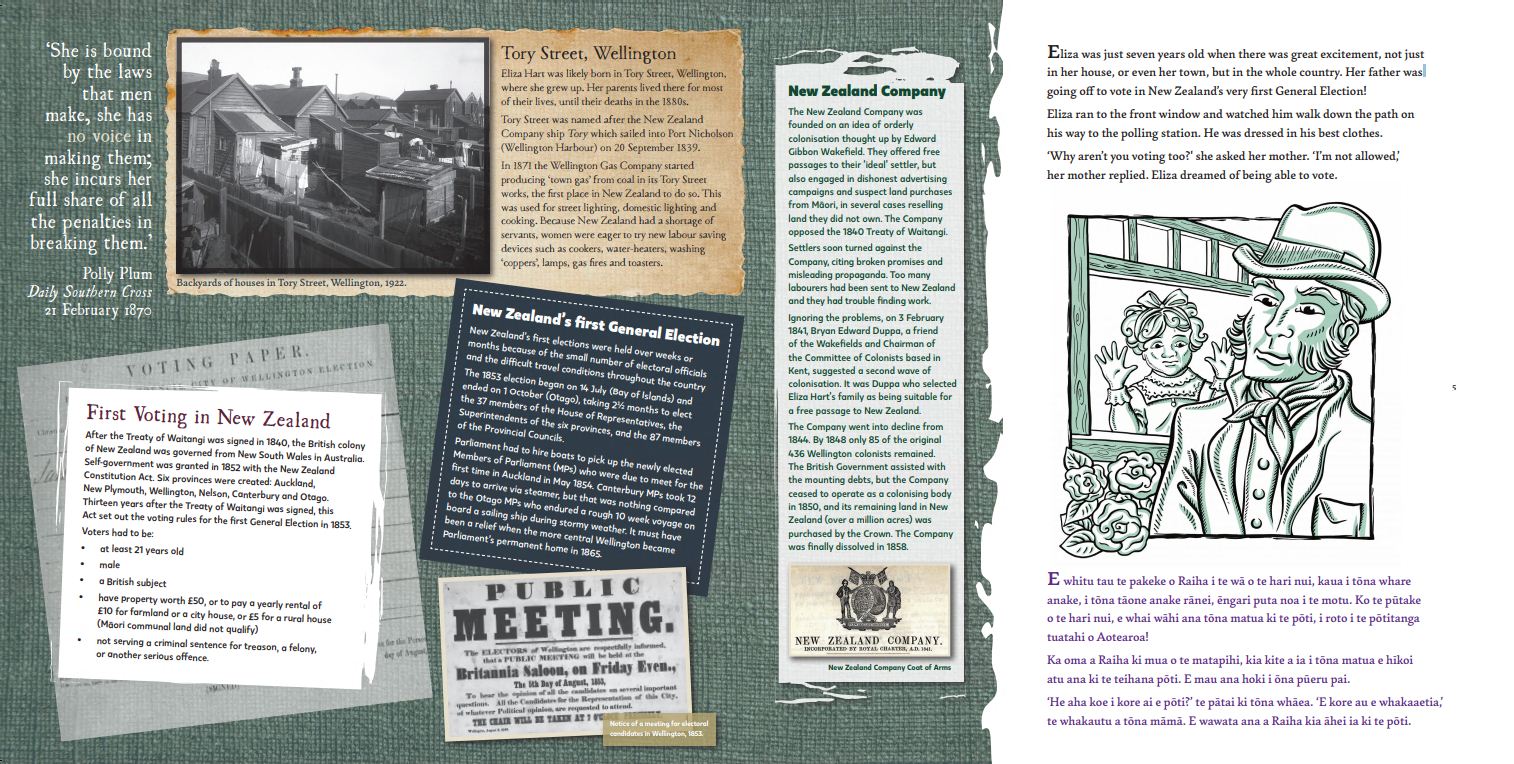
Eliza and the White Camellia: A Story of Suffrage in New Zealand, by Debbie McCauley, illustrated by Helen Casey, nā Tamati Waaka i whakamāori
This is a fantastic achievement from Debbie McCauley, combining her own thoroughly researched and interesting family history, with the broader history of New Zealand. This doesn’t only include women’s suffrage, though that plays a large part throughout the main story within the book, but also includes elements of the social history of England, convict history, and the dramatic tale of Minnie Dean.
Eliza and her daughter Emily were founding members of the CWI, the Canterbury Women’s Institute, which worked closely with the women’s temperance unions to spread the word on the evils of alcohol, and the abilities of women to make their own decisions. Their lives were intertwined with that of Kate Sheppard and her family, though with what ended up being 12 children, Eliza perhaps did a little less travel than Kate in support of the cause.
Emily, Eliza’s first daughter, had an illegitimate child, who was adopted at birth, retrieved by Eliza and her husband for a time, then adopted again by Minnie Dean and her husband. She was given back to her family when the penny dropped on Dean and her baby-farming ways, and later on appeared to have lived with Kate Sheppard and her husband for some time.
This is a fantastic achievement from Debbie McCauley, combining her own thoroughly researched and interesting family history, with the broader history of New Zealand.
Debbie’s main story is clear and coherently told in the left-hand margin of the page, and is translated into te reo Māori at the bottom of each page. There is also a really welcome passage on how Māori women worked alongside the European women (many of whom were recent arrivals) to gain suffrage.
Three-quarters of each spread is taken up with a startling array of fact boxes, giving a really thorough background to anybody studying suffrage, or early New Zealand history. McCauley is a skilled researcher. The final pages of the book are taken up with a history of women’s politics in New Zealand, a history of suffrage in other countries, and some inquiry-based teaching notes. There are even some craft ideas to do on suffrage day.
This review is done from a PDF version of the book, which proved rather intractable when I was trying to make it work smoothly, so this review is a bit more of a collection of impressions than I would usually write. However, I do recommend this for Intermediate school groups and junior high school years who are running an enquiry about women’s history in New Zealand. It does an excellent job of explaining the full background of women’s rights, and is full of sources to follow up.
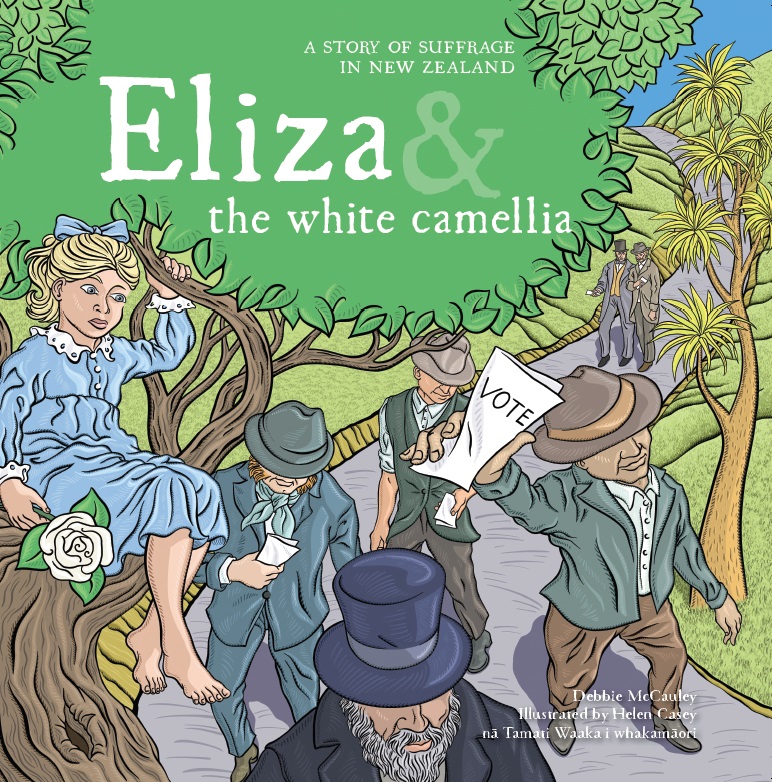
Eliza and the white camellia
By Debbie McCauley
Illustrated by Helen Casey
Nā Tamati Waaka i whakamāori
Published by Mauao Publishing
RRP $38

Sarah Forster has worked in the New Zealand book industry for 15 years, in roles promoting Aotearoa’s best authors and books. She has a Diploma in Publishing from Whitireia Polytechnic, and a BA (Hons) in History and Philosophy from the University of Otago. She was born in Winton, grew up in Westport, and lives in Wellington. She was a judge of the New Zealand Book Awards for Children and Young Adults in 2017. Her day job is as a Senior Communications Advisor—Content for Te Herenga Waka—Victoria University of Wellington.



